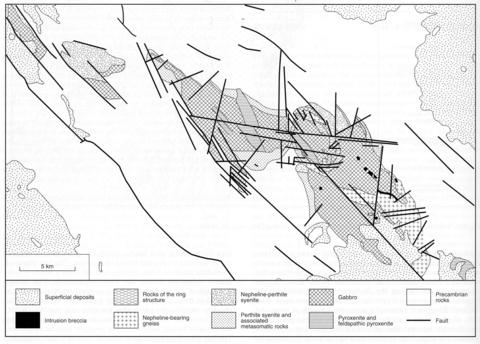stripes
Emplaced in Precambrian (Ubendian) gneisses, the Mbozi complex has an overall length of 37 km and maximum width of 12 km. The complex is irregular in outline but there is a ring structure towards the centre of the complex although this, and the complex generally, is heavily faulted, many of the faults trending northwest-southeast parallel to the main rift faulting. The oldest and most abundant rocks of the complex are layered gabbros which were deformed, faulted and intruded by dolerite dykes before emplacement of the alkaline rocks. Alkaline rocks generally lie between the gabbros and country rocks in zones that vary in width from a few metres to a kilometre or more, but are also present as a ring and as an extensive area of nepheline-bearing gneisses at the southeastern end of the complex. The basic rocks have a large-scale compositional layering and locally fine rhythmic layering; they are predominantly gabbroic but with pyroxenite and anorthosite bands. These rocks comprise titaniferous augite, bytownite, olivine, usually with a rim of clinopyroxene or brown amphibole, magnetite and amphibole. The alkaline rocks that generally envelop the basic rocks are variously homogeneous and heterogeneous syenites and nepheline syenites, the latter being confined to the central area of the complex. The dominant mineral is perthite which is generally tabular and often aligned parallel to the contacts. Nepheline is interstitial but in nepheline-rich rocks (30-50% nepheline) forms aligned prisms. Biotite is the principal mafic mineral but amphibole and diopside - aegirine-augite also occur; accessories include sodalite, magnetite, titanite, zircon and rarely pyrochlore. Against the Ubendian gneisses a contact zone up to 100 m wide occurs in which there is development of alkali feldspar and alteration of mafic minerals. Along the southwestern contact of the northern half of the complex, along syenite dykes and faults, extensive metasomatism of gabbroic rocks has occurred with the production of alkali feldspar and replacement of pyroxene by sodic amphibole and sometimes by biotite. At both the northern and southern ends of the complex are heterogeneous quartz-bearing syenites which have a gneissic structure and contain discrete sodic and potassic feldspars, sodic amphibole, biotite and accessories including melanite. Brock (1968) considers these rocks to be of metasomatic origin. An extensive area at the southeastern extremity of the complex, and smaller masses elsewhere, are of nepheline-bearing gneisses. They are banded rocks varying from coarse- to fine-grained, leucocratic to melanocratic and foliated to unfoliated. Ubiquitous nepheline syenite veins may be concordant or cross-cutting. Leucocratic bands consist of K-feldspar, sodic plagioclase, perthite, sodic amphibole, aegirine-augite with minor magnetite, titanite, zircon, melanite, carbonate and rare pyrochlore. Melanocratic bands may show evidence of being metasomatized gabbro i.e. relicts of titanaugite and bytownite, but other rock types may be of a different paragenesis. The origin of the nepheline gneisses is discussed by Brock (1968). The central ring intrusion consists of a much faulted, but almost complete, ring of nepheline-rich rocks emplaced in gabbroic rocks with patches of nepheline-bearing gneiss on the northern and southern margins. The rocks of the ring are banded and extremely heterogeneous, and Brock (1968) considers that only 5% are undoubtedly intrusive, the origin of the rest being far from clear, but he considers that metasomatism of gabbro played a large part. Nine groups are distinguished based on plagioclase composition, nepheline content and presence or absence of K-feldspar, but sodic amphibole and sodalite are locally abundant, indeed, the last two minerals may form as much as 60-70% of some varieties. Clearly intrusive rocks forming veins and dykes up to 30 m wide include nepheline syenites, litchfieldite and rutterite, the last two containing sodalite, often in greater abundance than nepheline. The extreme textural, modal and mineralogical variations of the rocks are explored in detail by Brock (1968), who gives a number of rock analyses; three other analyses are available in Basu and Ikingura (1984). The amphibole 'mboziite' was described from nepheline syenite of a dyke (Brock et al., 1964).
BASU, N.K. and IKINGURA, J.R. 1984. Petrology of the marginal part of Mbozi syenite-gabbro complex, Mbozi district, Mbeya region, Tanzania. Journal of African Earth Sciences, 2: 155-60.BROCK, P.W.G. 1961. Mbozi syenite-gabbro complex. Quarter Degree Sheet, Mineral Resources Division, Tanzania, 257.BROCK, P.W.G. 1968. Metasomatic and intrusive nepheline-bearing rocks from the Mbozi syenite-gabbro complex, southwestern Tanzania. Canadian Journal of Earth Sciences, 5: 387-419.BROCK, P.W.G., GELLATLY, D.C. and KNORRING, O VON. 1964. Mboziite, a new sodic amphibole end-member. Mineralogical Magazine, 33: 1057-65.MACFARLANE, A. and BROCK, P.W.G. 1966. Tunduma. Mineral Resources Division, Tanzania, Quarter Degree Sheet, 257.SNELLING, N.J. 1963. Age Determination Unit. Overseas Geological Surveys Annual Report for 1962. 30-9.

